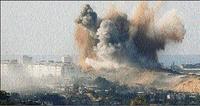
An explosion from an Israeli airstrike in the northern Gaza Strip as seen from the Israel side of the border with Gaza, yesterday. Palestinian militants fired rockets into southern Israel, yesterday, as Israeli warplanes and gunboats blasted more than two dozen Hamas positions, targeting weapons. - AP Photo
GAZA CITY, Gaza Strip (AP):
Thousands of Israeli troops, backed by columns of tanks, poured into Gaza after nightfall yesterday, setting off fierce clashes with Palestinian militants as Israel launched a much-anticipated ground offensive in a widening war on Gaza's Hamas rulers.
Israeli leaders said the operation, meant to quell militant rocket and mortar fire on southern Israel, would not end quickly, but that the objective was not to reoccupy Gaza or topple Hamas. The depth and intensity will also depend on parallel diplomatic efforts that so far have been unacceptable to Israel, the officials said.
About two and a half hours after ground troops moved in, Israeli Defence Minister Ehud Barak went on national TV to tell Israelis that the campaign "will not be easy and it will not be short".
"We do not seek war, but we will not abandon our citizens to the ongoing Hamas attacks," Barak said.
Hamas warned Israel that Gaza "would become a graveyard for you".
Israel mounted a bruising air campaign against Gaza eight days ago, striking hundreds of targets and killing some 500 Palestinians. The decision to expand the operation to a ground push, while continuing to batter Gaza from the air and sea, was taken after Hamas refused to stop attacking Israel, government officials said. They spoke on condition of anonymity because discussions leading up to wartime decisions are confidential.
reserves soldiers
At the same time, it called up tens of thousands of reserves soldiers in the event Palestinian militants in the West Bank or Hezbollah guerrillas in Lebanon decide to exploit the broad offensive in Gaza to launch attacks against Israel on other fronts.
The night sky over Gaza was lit by the flash of bullets and balls of fire from tank shells. Sounds of explosions were heard across Gaza City, the territory's biggest city, and high-rise buildings shook from the bigger booms.
Israel also kept pounding Gaza with airstrikes, with F-16 warplanes hitting three targets within a few minutes, including a main Hamas security compound.
Palestinian health officials said civilians were among the dead, including a woman, her son and her father who died after a shell hit their house.
Heavy Israeli artillery fire hit east of Gaza City, in locations where the military said Hamas fighters were deployed. The artillery shells were apparently intended to detonate Hamas explosive devices and mines planted along the border area before troops marched in.
Witnesses in Gaza said that in the first phase, Israeli ground forces had moved several hundred metres (yards) inside Gaza. Israeli security officials said initial clashes with militants took place in open fields and soldiers did not immediately move into Gaza's crowded cities, where warfare would likely get much deadlier.
In the initial, airborne phase of Israel's onslaught, militants were not deterred from bombarding southern Israel with more than 400 rockets - including dozens that extended deeper into Israel than ever before. Four Israelis were killed by rockets in that first phase.
The launch of the ground operation did not make Hamas any less defiant.
"You entered like rats," Hamas spokesman Ismail Radwan told Israeli soldiers in a statement on Hamas' Al Aqsa TV, broadcast shortly after the start of the invasion.
"Your entry to Gaza won't be easy. Gaza will be a graveyard for you, God willing," he said.
camouflage
Militants fired six rockets into Israel in the first few hours after the ground push began, the military said.
Gunbattles could be heard as Israeli troops crossed the border. Local TV networks broadcast images of troops with camouflage face paint marching single file. The troops were also backed by helicopter gunships.
Gaza is an impoverished territory of 1.4 million people who have been confined to their tiny coastal strip since Hamas violently seized power in June 2007, provoking and Israeli and Egyptian blockade. Israel maintained control of its border crossings with Gaza even after it pulled all 8,500 of its settlers and its soldiers out of the territory in late 2005.
Israeli Prime Minister Ehud Olmert said his government decided to mount a land operation despite the risk it posed to thousands of soldiers.
"I want to be able to go to the Israeli public and all the mothers and say, we did everything in a responsible manner," Olmert said in a statement released by his office. "In the end, we reached the moment where I had to decide to send out soldiers."
An inner Cabinet of top Israeli Cabinet ministers met with leading security officials for four hours Saturday before deciding to authorise the ground invasion. Olmert told the meeting that Israel's objective was to bring quiet to southern Israel but "we don't want to topple Hamas," a government official quoted the prime minister as saying. The official spoke on condition of anonymity because he was not supposed to share the information.